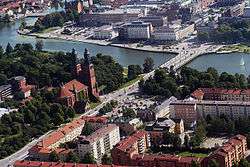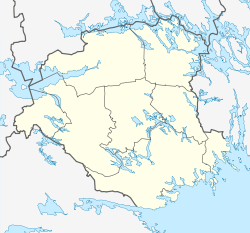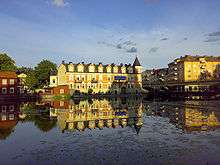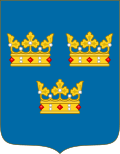Eskilstuna
Eskilstuna (Swedish pronunciation: [ˈɛ̂sːkɪlsˌtʉːna] (![]()
Eskilstuna | |
|---|---|
 Aerial photo of Eskilstuna in 2004. | |
 Eskilstuna  Eskilstuna | |
| Coordinates: 59°22′15″N 16°30′35″E | |
| Country | |
| Province | Stockholm |
| County | Södermanland County |
| Municipality | Eskilstuna Municipality |
| Founded | 1659 |
| Area | |
| • Total | 31.05 km2 (11.99 sq mi) |
| Elevation | 26 m (85 ft) |
| Population (2015)[1] | |
| • Total | 67 359 |
| • Density | 2,083/km2 (5,390/sq mi) |
| Time zone | UTC+1 (CET) |
| • Summer (DST) | UTC+2 (CEST) |
| Postal code | 630 03 to 638 21 |
| Area code(s) | (+46) 16 |
| Website | Official website |
History
Eskilstuna's history dates back to medieval times when English monk Saint Eskil made "Tuna" his base and diocese of the South coast of Lake Mälaren. Saint Eskil was stoned to death by the pagan vikings of neighbouring town Strängnäs, 30 kilometres (19 miles) east of Eskilstuna, trying to convert them to Christianity. Saint Eskil was buried in his monastery church in Tuna. Later the pagan city of Strängnäs was Christianised and was given the privilege of becoming diocese of South Lake Mälaren. Later "Eskil" was added in to the word "Tuna". However, the town of Eskilstuna did not receive municipal privileges due to its proximity to the medieval city of Torshälla. The monastery of Saint Eskil was completely destroyed by Swedish king Gustav Vasa during the Protestant Reformation and was replaced with the royal castle of Eskilstuna House. The city's first city privileges were granted in 1659, and its boundaries included Tunafors and the newly founded town of Karl Gustavs Stad ("City of Karl Gustav"), located on the west side of the river. Karl Gustavs Stad was built around the iron forges of master smith Reinhold Rademacher, encouraged by King Karl X Gustav. The first products of the forges were small arms and artillery.
Karl Gustavs Stad was a free town from 1771, where manufacturers and craftsmen were allowed to establish tax-free workshops and factories. The town was merged with the rest of Eskilstuna in 1879.

The city grew enormously during the Industrial Revolution and became one of the most important industrial cities of Sweden, earning the nickname "Stålstaden" ("The City of Steel"). Aside from firearms, the city also produced cutlery, scissors, keys, machine tools and precision instruments. As a tribute to the steel industry, the figure of a steel worker is included in the city's coat of arms. Eskilstuna is sometimes called The Sheffield of Sweden. Both cities at their peak were home to numerous steel production companies.
Economy
Eskilstuna remains an important industrial city with internationally known companies such as Volvo Wheel loaders, main site for the heavy construction equipment division of Volvo, Assa (locks, keys), and Stainless steel manufacturer Outokumpu, Thin Strip Nyby in Torshälla.
Mälardalen University (Mälardalens högskola), founded in cooperation with the neighboring city of Västerås, has a campus in the city. The city also has a combined zoo and amusement park - Parken Zoo.
The hospital, Mälarsjukhuset is one of the largest in the region, employing around 3000 people.
Climate
| Climate data for Eskilstuna | |||||||||||||
|---|---|---|---|---|---|---|---|---|---|---|---|---|---|
| Month | Jan | Feb | Mar | Apr | May | Jun | Jul | Aug | Sep | Oct | Nov | Dec | Year |
| Record high °C (°F) | 8 (46) |
10 (50) |
19 (66) |
23 (73) |
27 (81) |
32 (90) |
35 (95) |
33 (91) |
27 (81) |
21 (70) |
15 (59) |
10 (50) |
35 (95) |
| Average high °C (°F) | −2 (28) |
−1 (30) |
2 (36) |
10 (50) |
15 (59) |
20 (68) |
22 (72) |
19 (66) |
14 (57) |
8 (46) |
4 (39) |
−1 (30) |
10 (50) |
| Daily mean °C (°F) | −4 (25) |
−3 (27) |
−1 (30) |
6 (43) |
10 (50) |
14 (57) |
18 (64) |
16 (61) |
11 (52) |
5 (41) |
2 (36) |
−3 (27) |
6 (43) |
| Average low °C (°F) | −6 (21) |
−7 (19) |
−3 (27) |
3 (37) |
6 (43) |
10 (50) |
15 (59) |
13 (55) |
8 (46) |
3 (37) |
0 (32) |
−5 (23) |
4 (39) |
| Record low °C (°F) | −37 (−35) |
−27 (−17) |
−20 (−4) |
−12 (10) |
−6 (21) |
−1 (30) |
5 (41) |
3 (37) |
−1 (30) |
−13 (9) |
−23 (−9) |
−30 (−22) |
−37 (−35) |
| Source 1: SMHI | |||||||||||||
| Source 2: Swedish Wikipedia | |||||||||||||
Demography
| 1800 | 1850 | 1900 | 1950 | 2000 | 2010[3] | |
|---|---|---|---|---|---|---|
| Inhabitants[4] | 1 341 | 3 961 | 13 663 | 53 363 | 88 404 | 96 311 |
As of December 31, 2019 Eskilstuna has a population of 106 859 people, making it the 15th largest city in Sweden.[5]
Sport
The successful handball club Eskilstuna Guif remains in the top division. They have reached the Swedish Championship final four times (1997, 2001, 2009 and 2011), but lost on each occasion. Eskilstuna is also home to EFK (Eskilstuna Flygklubb), Sweden's largest glider Flying Club which hosted the World Gliding Championships in 2006.
Since 2017, Eskilstuna has a football team in the highest tier Allsvenskan, named AFC Eskilstuna, who changed both the team name and location from Solna after qualifying for the top league after the 2016 season, making them the first team in the Swedish top leagues of football changing hometown. The women's football team, Eskilstuna United DFF, has played in the highest tier since 2014, and finished as runner up in the 2015 season, making them qualify for the 2016–17 UEFA Women's Champions League.
The speedway team in Eskilstuna, Smederna, competes in the highest speedway league in Sweden, Elitserien and race its home matches at Smedstadion outside Eskilstuna.
In eSports, Eskilstuna is home to CS:GO player Maikelele.
The stadium Tunavallen was a venue for the 1958 FIFA World Cup, hosting one match between Paraguay and Yugoslavia. It has also been used for several practice games for the Swedish National Youth Teams. Sports clubs using Tunavallen include AFC Eskilstuna, Eskilstuna United DFF, Eskilstuna City FK and IFK Eskilstuna. Eskilstuna Södra FF are based at Skogsängens IP and BK Sport is based at Ekängen.
Athletes from Eskilstuna
|
Footballers
|
Transport
Eskilstuna is served by the Svealandsbanan railway line between Stockholm and Hallsberg. European route E20 passes the city. The city has an airport, 13 km (8 mi) east of the centre.
European Cooperation
Eskilstuna is a member city of Eurotowns network[6]
Other notable natives
MusicBands
|
Musicians
|
Miscellaneous
|
See also
References
- "Tätorternas landareal, folkmängd och invånare per km2 2005 och 2010" (in Swedish). Statistics Sweden. 14 December 2011. Archived from the original on 2012-01-10. Retrieved 10 January 2012.
- "Archived copy". Archived from the original on 2007-12-19. Retrieved 2010-01-20.CS1 maint: archived copy as title (link)
- "Befolkning - Eskilstuna kommun". www.eskilstuna.se (in Swedish). Retrieved 2020-03-11.
- Johannesson, Gösta (1978). Från köpstad till storkommun. Stockholm: Natur & kultur. p. 141.
- "Folkmängd, topp 50". Statistiska Centralbyrån (in Swedish). Retrieved 2020-03-10.
- "Eurotowns".
External links
| Wikimedia Commons has media related to Eskilstuna. |
- Eskilstuna - Official site (in Swedish, French, German, English and Finnish)
- Tågtider för Eskilstuna C
